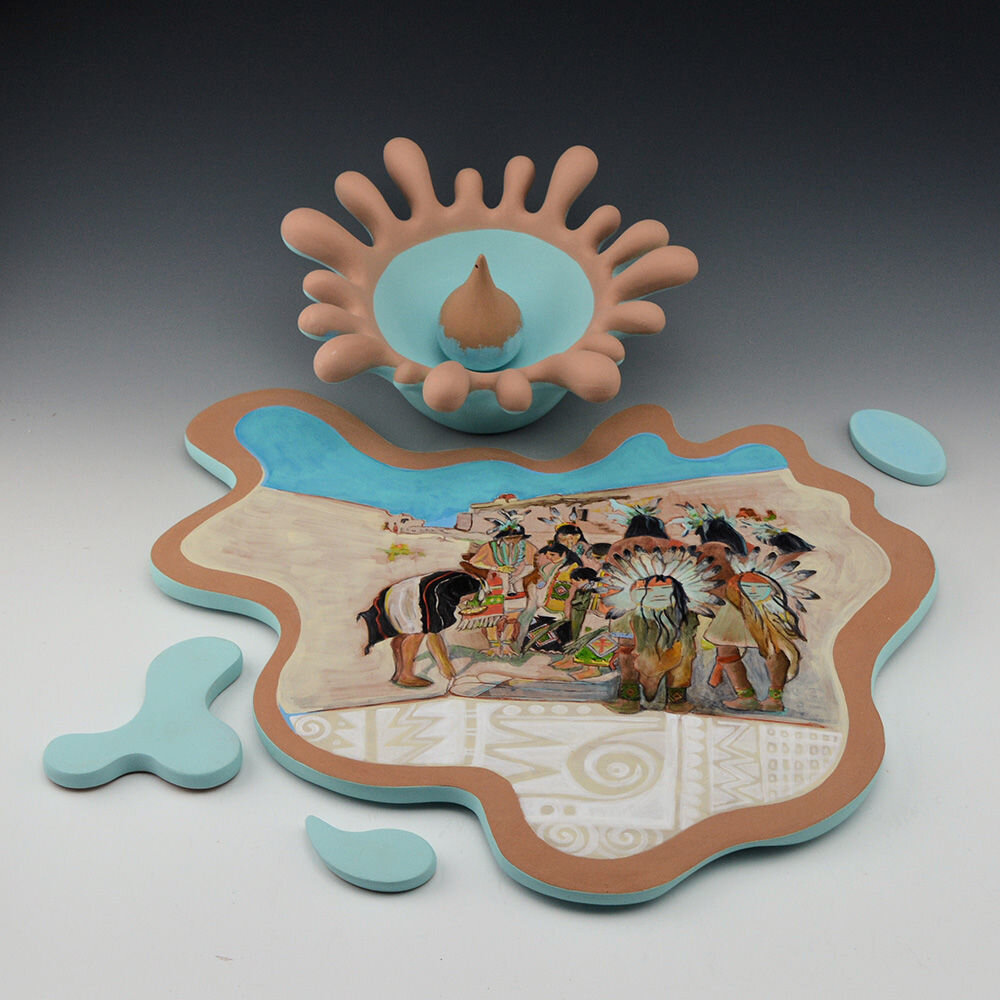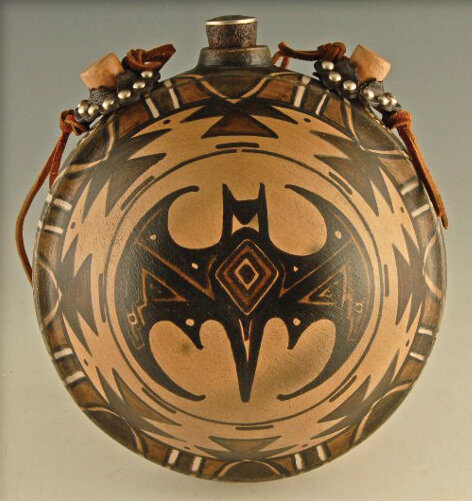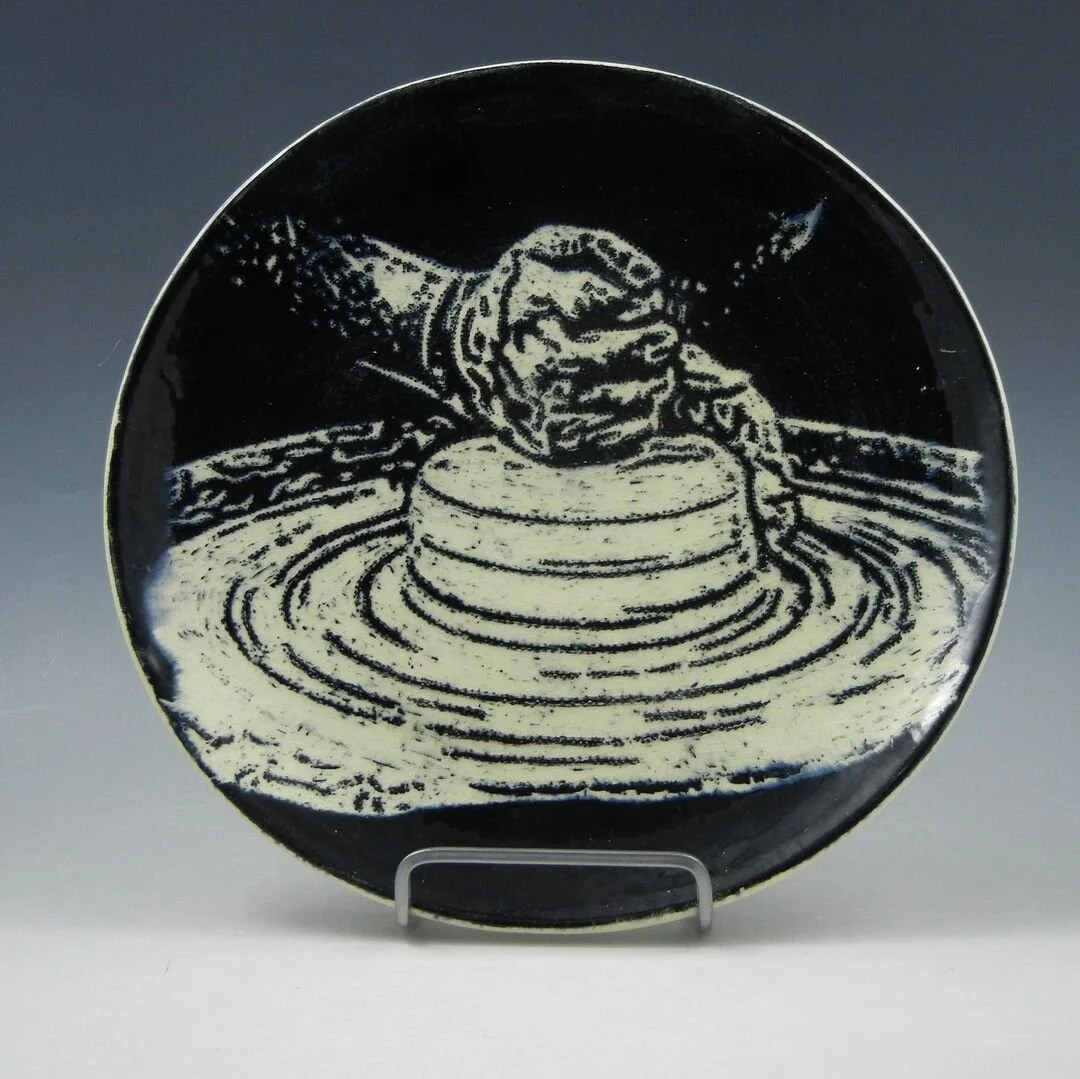Susan Folwell and Shalom Parker: understanding the whole story
As a Brit, Thanksgiving in the USA often seems to be a slightly mystifying event, the subject of imported TV shows’ episodes featuring food, jars of cranberry sauce and family – and not enough context for overseas viewers. These days it’s the day before Black Friday, but no one quite knows why a shopping event would be on a Friday. So since Thanksgiving is ultimately something which most people of our island don’t really know the history behind, we can add it to the list of things that happened abroad throughout history which were somehow Britain’s fault, but about which British people are still woefully ignorant. However, this isn’t a post about the history of Thanksgiving – it is a post celebrating two amazing contemporary artists with Native American roots whom I have been researching for the exhibition.
“To be born and raised in Santa Clara Pueblo has been a deep blessing. I am deeply rooted in the tradition, and I find artistic inspiration from moving back and forth between two worlds. The world I find around me is deeply turbulent, and yet there is beauty there. As the world reveals itself to me, I find my inspiration.”1
Susan Folwell grew up in a pottery making family like no other, surrounded by clay and creativity. Her grandmother was ‘Living Treasure’ Rose Naranjo, her mother is the celebrated potter Jody Folwell, her sister is Polly Rose Folwell and now, with the next generation of this amazing lineage emerging, she is the aunt of Kaa Folwell. Each member of the family takes the traditions of Pueblo pottery and pushes the boundaries; in Susan’s case that includes using pop art references, advertising imagery and references to contemporary issues that affect herself and Native American communities. Folwell creates her pieces using Santa Clara Pueblo firing methods and local native clays, dug by hand.
“What is frustrating is how limited many people are in their ideas of what the pottery is supposed to be saying. They want a white buffalo or a howling wolf, a bear claw or ‘the Indian with wind in the hair’—you know the picture, the ‘beautiful’ Native American staring serenely into the distance with a faraway look in his eye while the wind whips his hair. Usually an eagle feather dangles somewhere in the background. This romanticized version of stereotyped Native imagery makes me angry and frustrated, since to me it represents how our people have always been exploited by providing images of what non-Native people think we should look like or be like. This is what people think Indians are, so this is what we must make or do. No one likes to think about it because the word ‘exploitation’ makes us uncomfortable, but to ignore it is to perpetuate it.”2
Folwell’s use of local clays and her interpretation of native designs creates the basis for her art. Her inspiration coming from personal and world events, Folwell’s pottery blends catharsis of the modern spirit and disappointment with the contemporary world with references to pop art imagery and marketing slogans. The forms become the canvas for her designs, which are carved, etched and painted onto and into the clay. The designs are a blend of innovation and Pueblo tradition, ideal and metaphor, spiritual and social.
“Viewing Susan Folwell’s intricately designed pottery is like reading a book, as each piece must be turned, examined and viewed from different angles to understand the whole story”3
Whereas Folwell’s ceramics show their keen awareness of their starting position within both the audience’s minds and the artist’s vision, the ceramics of Shalom Parker’s Our Hands project are very much those of an early-career artist finding both her own voice as an artist and her own position within the history of her family.
“As soon as I had the opportunity to take a ceramics class in high school, I jumped on it and have never looked back. Our Hands was my senior show while in my undergrad program. When I was thinking about my identity as a ceramic artist I felt so alone in my department and within the field as a whole because I was unaware of any other ceramists of color. I eventually realized that before I explored how I fit into the history of ceramics; I needed to explore how I fit into the history of my family.”4
Our Hands featured starkly monochrome plates that Parker encouraged audiences to interact with, handle and explore, and was presented in a reassuringly domestic setting on a family dining table. I see parallels with how, as a British person, I encounter Thanksgiving via TV shows: just as families learn so much about each other at the large holiday gatherings in these programmes, so Parker was both learning and presenting her family history around the dining table through these plates.
“I actually didn’t know about my Cherokee heritage until I started researching my family history for this show. In my conversation with my grandmother, I discovered that my great-great grandmother was full Cherokee. I am very hesitant to reference it more in my work until I learn more about the culture and history. I know that I am perceived by most people to be a black woman, and I am treated as such regardless of what I say. I am personally very aware how all of the different cultures have mixed together and made me who I am and that is a big part of what the Our Hands series depicts. It plays out in so many different ways and has informed the way that I view the world, but I have given up trying to influence the way others see me.”5
People in the south-eastern part of North America have had a symbiotic relationship with the earth for more than 4000 years. Pottery was produced using moss to prevent shrinkage in firing on the North Carolina coast at least 4500 years ago, and almost 3000 years ago Cherokees were making pottery decorated by using carved paddles in the Southern Appalachian Mountains. From the 1300s until the Removal era, when Cherokees were forced out of their homeland east of the Mississippi River to designated lands west of the Mississippi following the Indian Removal Act in 1830 and the discovery of gold in Georgia, there was a continuous tradition of pottery known as the Qualla style.
“The romantic in me likes to imagine that I had relatives generations ago who were also potters. Sadly, there is no way to trace my specific family line back that far, so I am left to imagine it.”6
I wanted to touch on Parker’s Cherokee heritage in this blog post, not to try and link her to the history of Cherokee ceramics in the way Folwell is linked to the history of Santa Clara Pueblo ceramics, but because of Bideford’s links to the early European settlements on the east coast of North America. Bideford grew as a port in the 1600s, becoming the second busiest port in England at the time, importing tobacco and exporting earthenware; by the 1680s Bideford and Barnstable were exporting tons of earthenware storage vessels and jugs and had a ceramics industry that would have rivalled that in Staffordshire at the time.
Unlike this country’s history of ceramic industries where men tended to throw pots and women sometimes got to decorate pieces in the Wedgwood or Spode factories if they were lucky, the history of Native American pottery was shaped almost exclusively by female makers. Susan Folwell’s family are just the tip of the iceberg of both contemporary and traditional Native American pottery, but I would highly encourage you to spend a bit of time indulging yourself in this rich history here, here and here.
So, in the spirit of Thanksgiving, I am thankful for being able to find and research Native American pottery from my desk in the UK during lockdown. And I am very excited to see where Susan Folwell takes her practice next, and to watch the development of Shalom Parker and Kaa Folwell as early-career and brilliant female artists.
These blog posts are published monthly, but if you want to access more exclusive content and to help my research, please consider supporting me on Patreon.
I also post photos daily to my Instagram profile.
Edited by Sarah McGill
1-2 – Susan Folwell; Susan Folwell; 2001; https://www.southwestart.com/articles-interviews/featured-artists/susan_folwell
3 – Charles King; Pueblo Pottery: Folk Art to Fine Art – Contemporary Innovators; 2005; American Indian Art Magazine
4-6 – Shalom Parker; email correspondence with the author; 2020
Susan Folwell; It’s All Over
Susan Folwell; Bringers Of Rain; 2019
Susan Folwell; Large Jar
Susan Folwell; Lone Ranger Love
Susan Folwell; Batman Water Bottle
Shalom Parker; My Sister Writing; 2015
Shalom Parker; My Father Praying; 2015
Shalom Parker; Chained Slave; 2015
Shalom Parker; Self-Portrait Making The Plates; 2015








